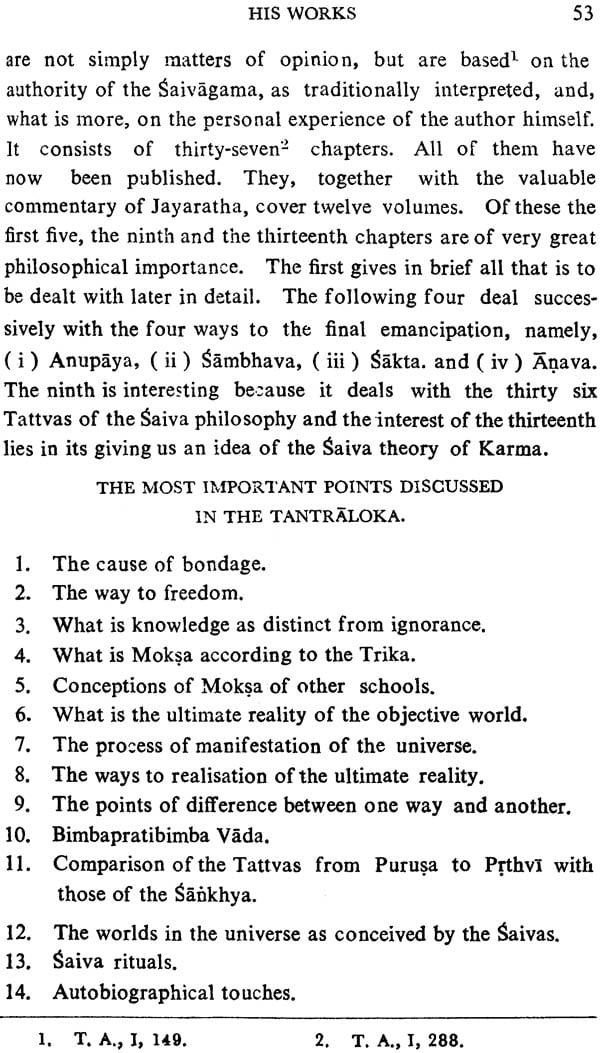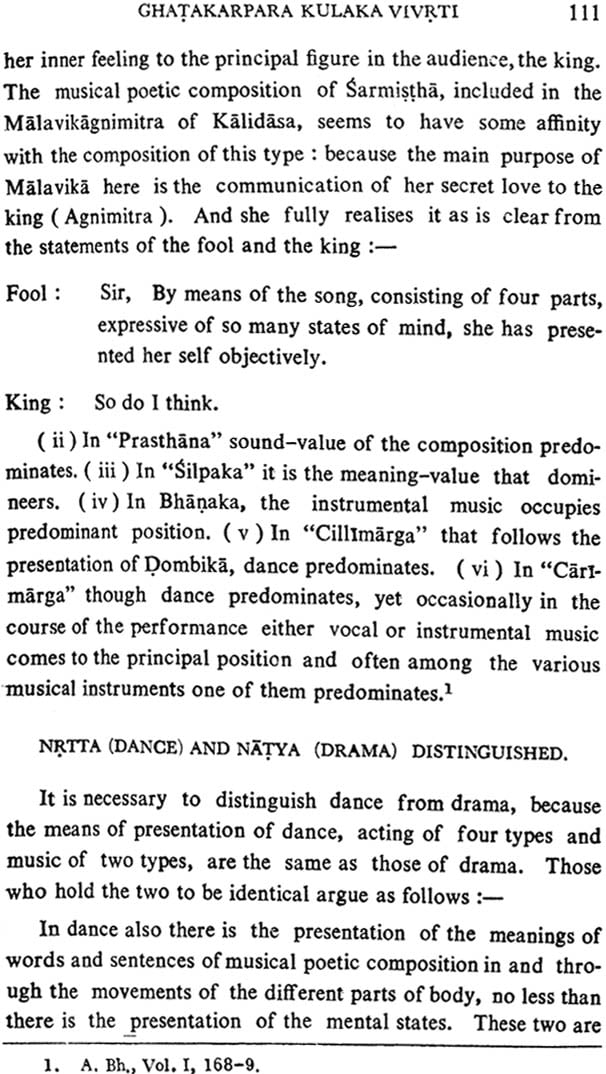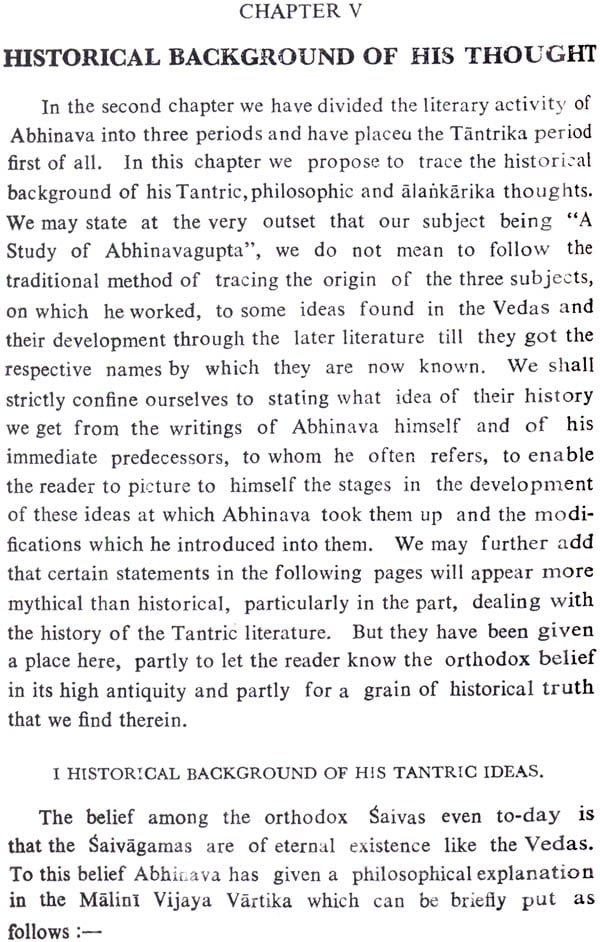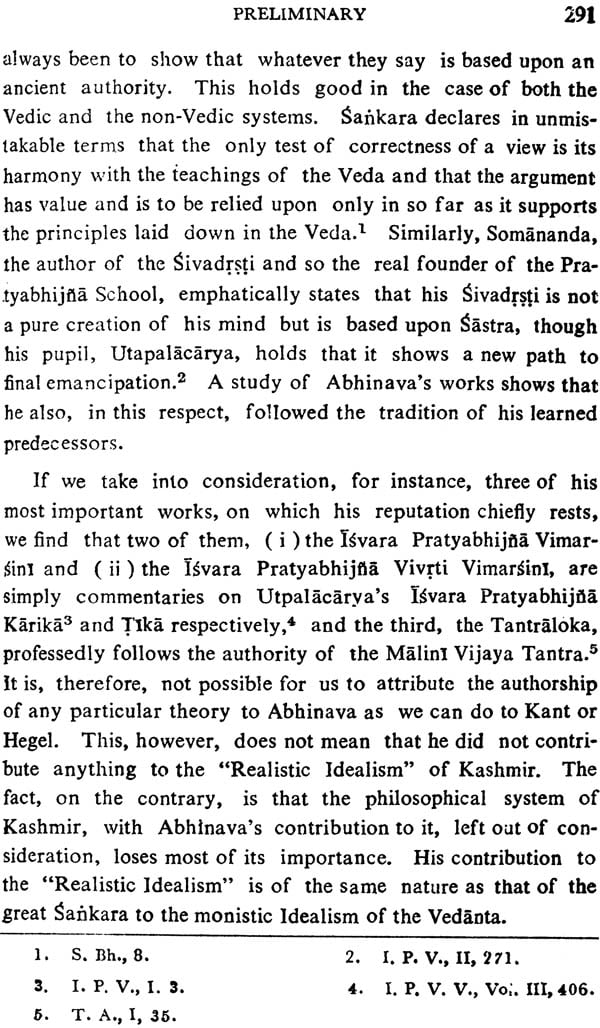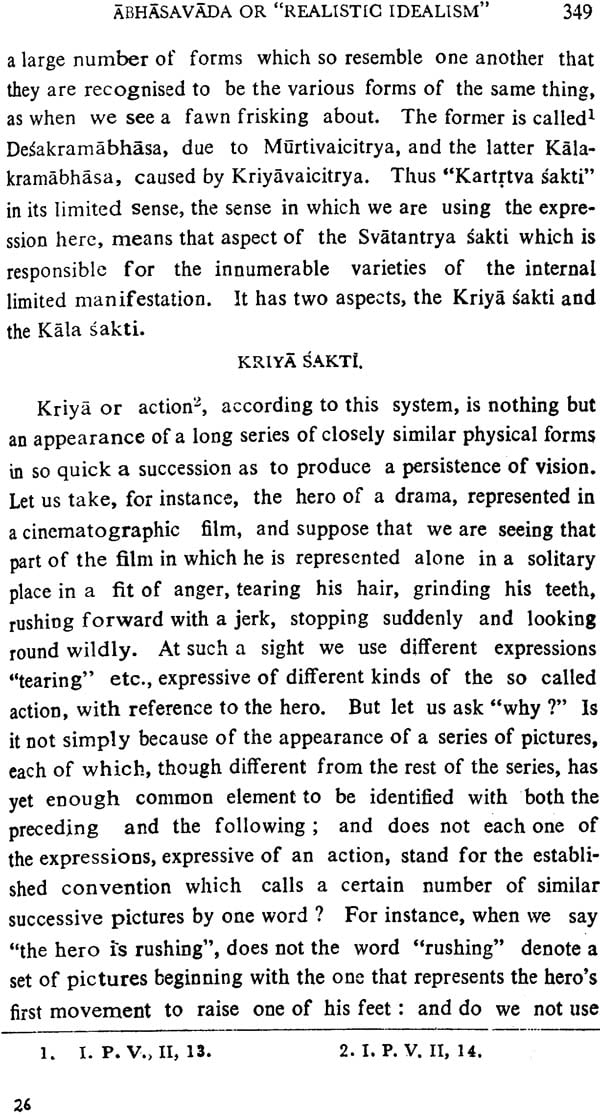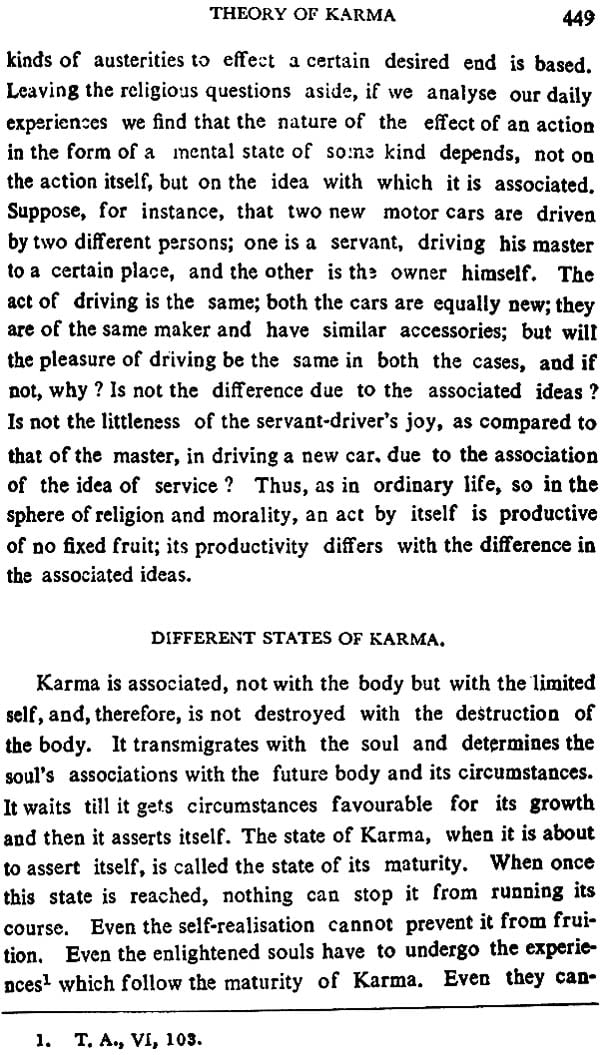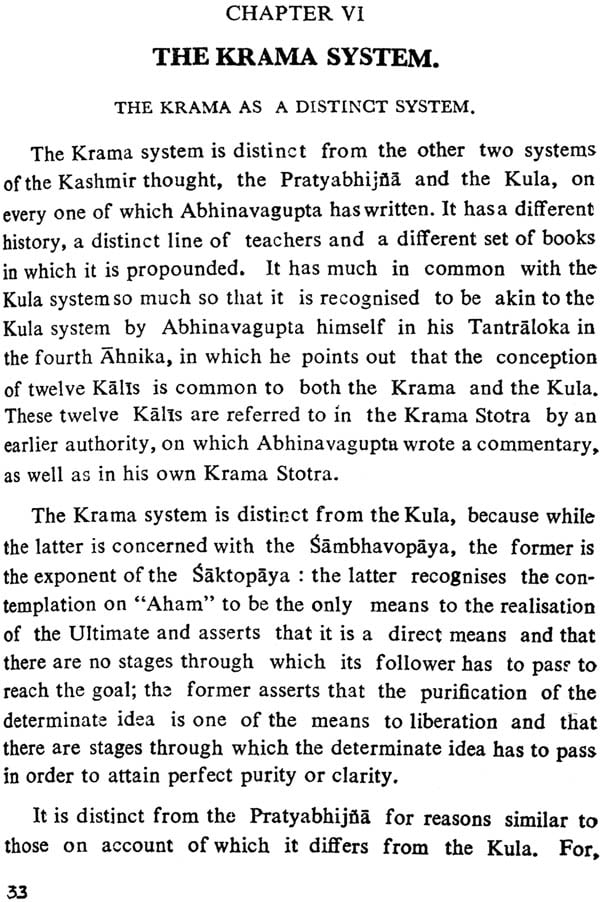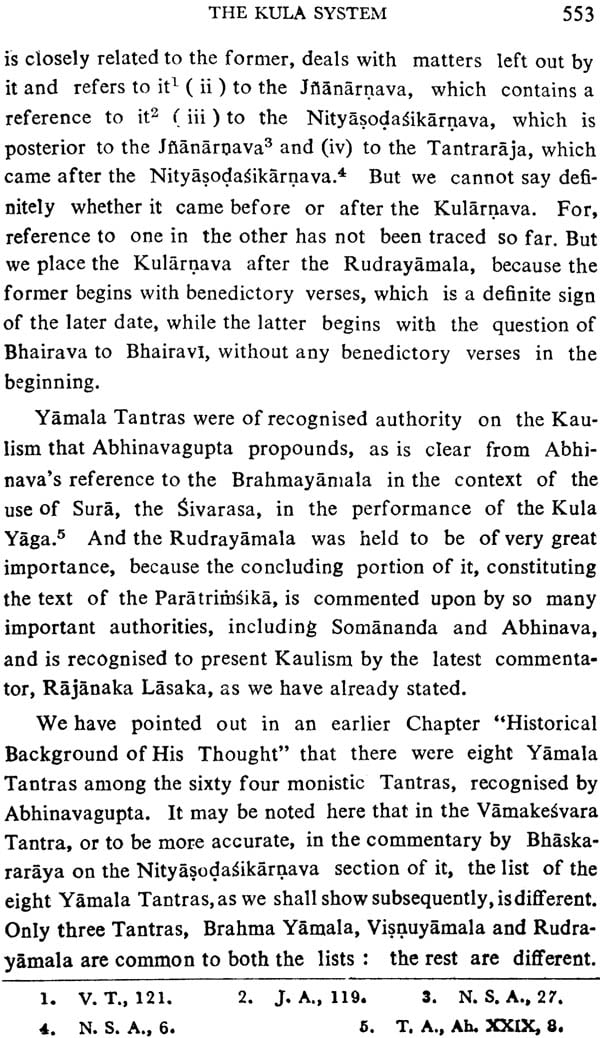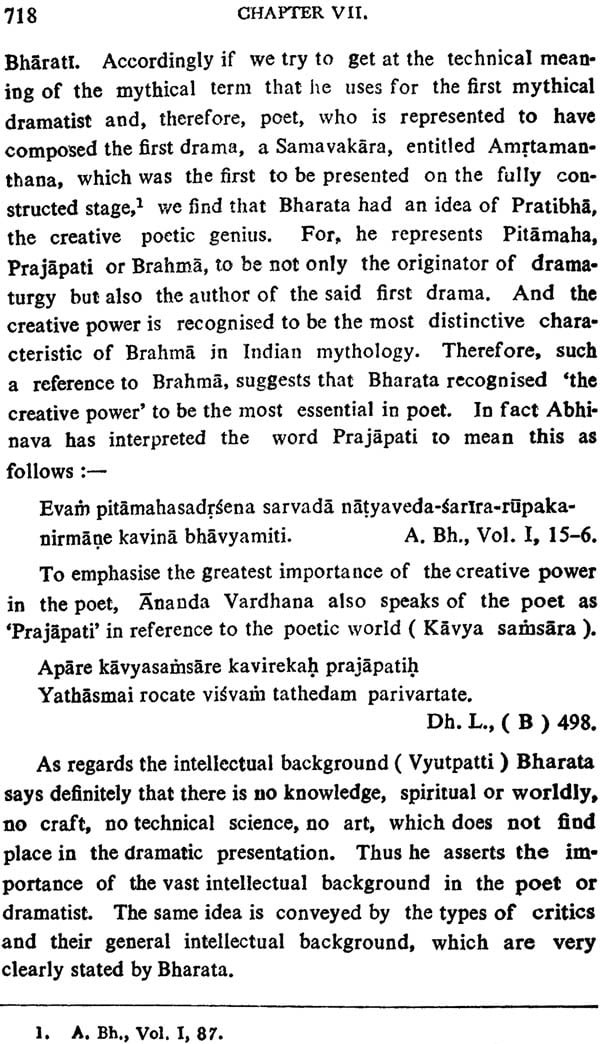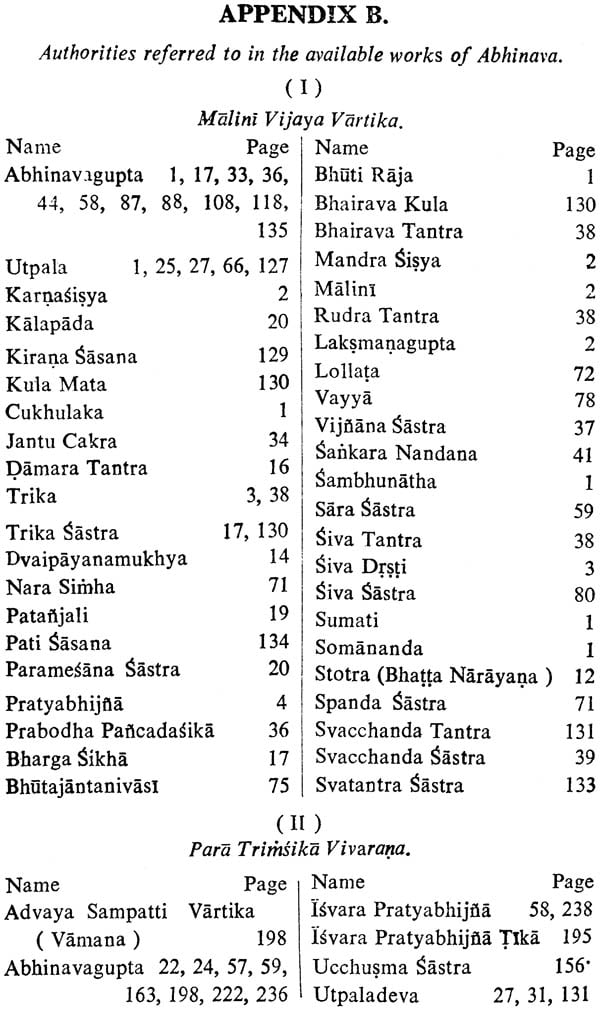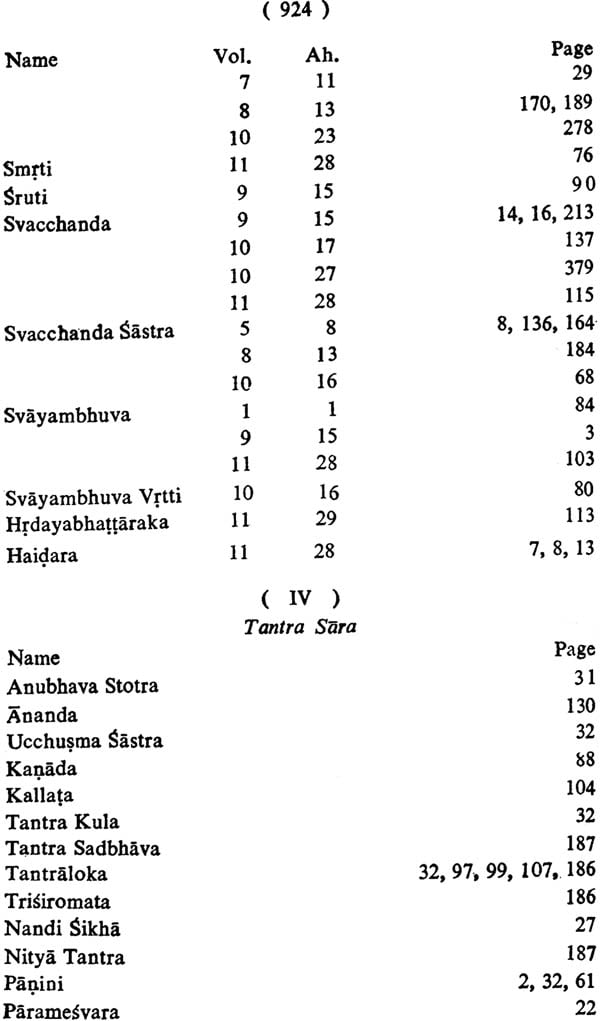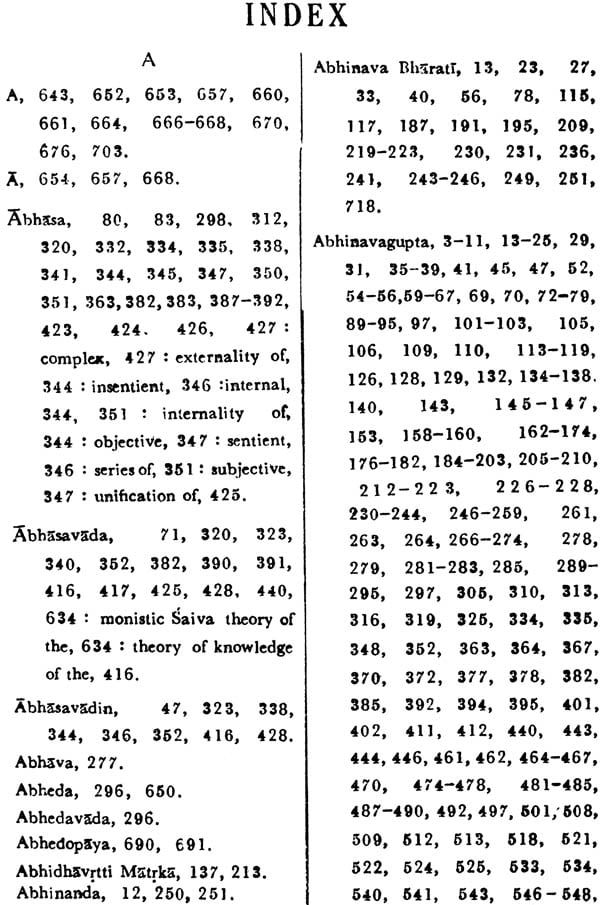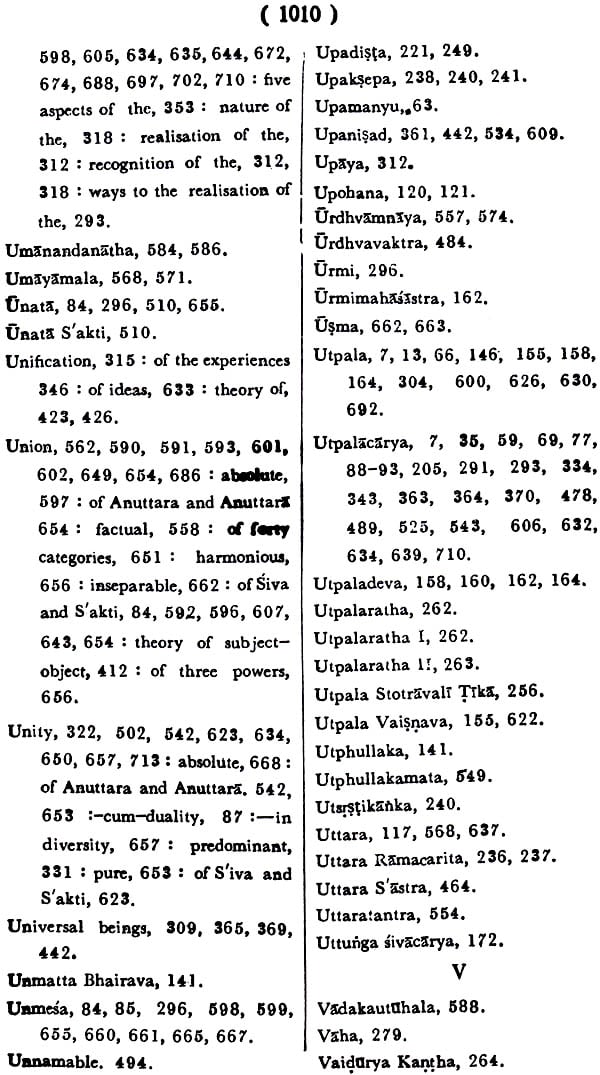
Abhinavagupta: An Historical and Philosophical Study (The Most Comprehensive Book Ever Published on Abhinavagupta)
Book Specification
| Item Code: | IDE579 |
| Author: | Prof. Dr. Kanti Chandra Pandey |
| Publisher: | Chaukhamba Amarabharati Prakashan |
| Language: | English |
| Edition: | 2018 |
| ISBN: | 9788192425238 |
| Pages: | 1066 (Color Illus: 1) |
| Cover: | Hardcover |
| Other Details | 9.0 inch X 6.0 inch |
| Weight | 1.17 kg |
Book Description
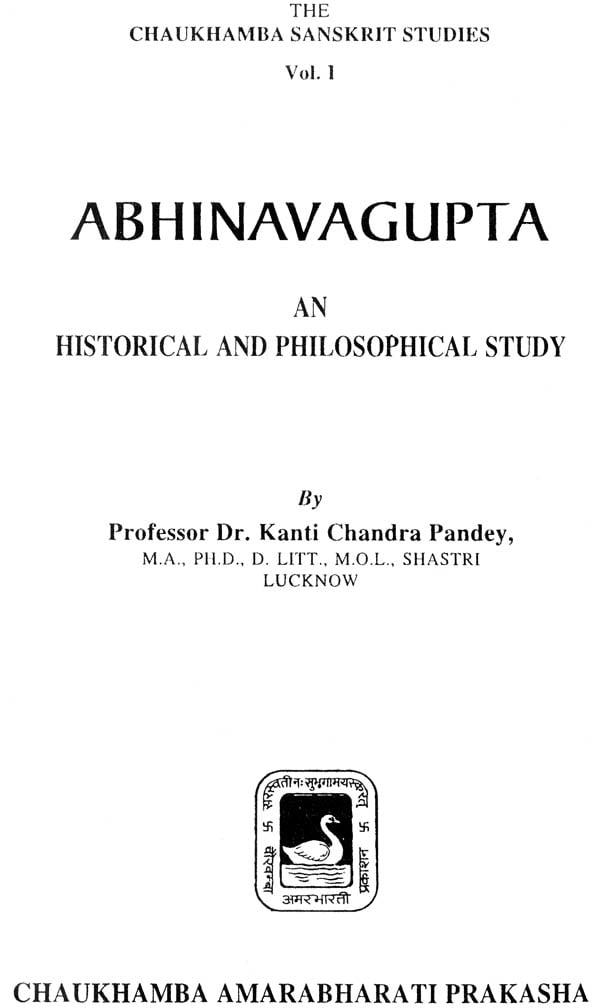
Introduction To The Second Edition
The opportunity to bring out the Second Edition has been utilized for adding an offset picture of Abhinavagupta and four new Chapters, besides giving a more complete account of his life, works and historical background of his thought.
The authenticity of the picture in paint lies in its being a faithful representation of the pen-picture, drawn by his pupil, Madhuraja Yogin, who was present at the celebration of the 'recognition of Abhinavagupta as the spiritual head of all the Saiva sects by the contemporary great spiritualists, both male and female.
The picture has a religio-philosophical significance; because it presents him as a typical follower of the Kula system. Two 'Dutis', each with a jar of Siva-Rasa, a kind of intoxicant, in the right hand and a lotus-flower and a citron-fruit in the left, are waiting upon him and dance, song and music are going on in front of him; but his mind, being in touch with the Reality, is experiencing the spiritual bliss, and the expression of his eyes stands as a witness to it. For, the characteristic feature of the Kaulism is that it denies antagonism between sensuous joy and spiritual bliss (Ananda); recognises the former to be a means to the latter; and emphatically asserts that it is meant for the few, who are highly proficient in the Raja-Yoga as distinct from the heath-Yoga, who have such a control over the mind that they can withdraw it from the stimulating object even at a time when it is being enjoyed most and concentrate it on the tip of Susumna.
It has an aesthetic significance. Abhinavagupta is a well recognised authority on Saivaism in general and on poetics, dramaturgy, music, aesthetics and the three monistic systems of the Saiva philosophy, dealt with in the present edition, in particular, on account of the 48 works which his powerful pen produced. The picture presents his as a practical musician, playing upon Nada-Vina, a stringed instrument, capable of producing the original musical sound, called Nada, and experiencing the transcendental bliss (Ananda). It shows that his assertion that the sensuous aspect of a work of fine art leads an aesthete, who possesses the necessary subjective conditions, to the highest level of perfects bliss through the imaginative, emotive and Kathartic levels, is based upon his personal experience.
It has an historical importance; because it presents an important event in the history of Sanskrit Literature in so far as it presents Abhinavagupta explaining the sections on music in the Natya Sastra of Bharata to his pupils, Ksemaraja etc., who are attentively listening to him and are taking down the words of the master: and also because it reflects a very important religio-philosophical movement in the 10th century A. D.
The pictorial art can present just one moment of life of its object of presentation which the pictorial genius conceives to be the most important visual aspect, inasmuch s it reflects the inner being in a way that suggests the state of consciousness, self or Atman. Accordingly the central fact, presented in the picture, is the expression of the eyes, which suggests the rest of the self in itself, the experience of the Self of Itself. (Svatma-paramarsa).
Two of the smaller works of Abhinavagupta (i) the Paryanta Pancasika and (ii) the Ghatakarpara Kulaka Vivrti have been given a small Chapter each, because there is a misunderstanding about them in the minds of some scholars.
The two monistic systems, the Krama and the Kula, which developed side by side with the Pratyabhijna, are known to few. The Kashmir Saiva thought, therefore, has been identified with the Pratybhijna only. Accordingly the philosophical works of Abhinavagupta are attempted to be interpreted in the light of this known system. Hence arose the misunderstanding about the system of philosophy, presented in the Paryanta Pancasika. The third Chapter in the historical part of this work attempts to remove it.
There are very few poetic production in the vast Sanskrit Literature, which present so many problems as does the Ghatakarpara Kulaka. A separate small chapter, therefore, has been devoted to it to solve them in the light, thrown on them by Abhinavagupta's commentary, the Vivrti, on it. It shows that the poem "Ghatakarpara" does not simply reverse the "motif of the Meghaduta by making a love-lorn lady, in the rainy season, send a message to her lover" : that the word "Kulaka", which is an essential part of the title of the poem, according to Abhinavagupta, does not mean a set of five or more verses with only one finite verb, as it is ordinarily understood to mean : on the contrary, it means a type of musical poetic composition (Gita-Kavya) - consisting of a group of songs, which presents one theme and, therefore, the members of which are well connected with one another,-meant for presentation on the stage in a manner different from that of a drama inasmuch as in it singing, acting and dance follow one another: that such poems were not only being staged at the time of Abhinavagupta : that it belongs to the highest type of poetry inasmuch as it is highly suggestive, as has been pointed out by Abhinavagupta in his commentary: that the repetition of different groups of letters (Yamaka) in it is not a sign of laboured composition, nor is its condemnation by our contemporaries as a low type of poetry justifiable, in the light of Abhinavagupta's critical estimate of it, which seems to have anticipated such an adverse criticism : that, according to Abhinavagupta, who follows the Kashmirian tradition about it, it is from the pen of Kalidasa and that the status of Kalidasa as the topmost poet is not adversely affected by this poem; for, the use of Yamakas in it gives such a musical value to it as enhances its emotional and aesthetic value. The Kashmirian tradition about Kalidasa's authorship of the Ghatakarpara Kulaka seems to be supported by the fact that in the Malavikagnimitra, the musical poetic composition of Sarmistha is a poem of this type.
The sixth Chapter in the philosophical part presents the Krama system in a proper historical perspective and gives an account of the literature on and of the exponents of it. It is a monistic system. Like the dualistic-cum-monistic Saiva system, propounded by Lakulisa and known as Lakulisa Pasupata, it has a pentadic tendency: it thinks in terms of groups of five concepts or postulates. Accordingly the basic pentad, which represents the five forms in which the Absolute manifests itself, consists of the five, Vyomavamesvari etc., and the aspects of speech, which are recognised to he three by Bhartrhari in his Vakyapadiyam, four by Somananda in his Siva Drsti, are admitted to be five, adding Suksma to the generally recognised four, Para, Pasyanti, Madhyama and vaikhari. It is a Sakta system, not only in its ritualistic aspect, in which it enjoins the use of wine, woman and meat, but also in its philosophical aspect inasmuch as it recognises the Ultimate Metaphysical Principle to be Kali and advocates the following of the Saktopaya for the realisation o the Reality. It asserts that the ethical value of an action is entirely determined by the motive. Hence the use of the prohibited, such as wine etc., in the ritual does not mean moral turpitude, because the motive in it is not the satisfaction of the senses, but the realisation of the Real.
The last Chapter deals with the Kula system. It traces the history of the system from the 5th century A. D., when it was propagated by Macchanda alias Mina, to the 18th century A. D. when Bhaskara Raya wrote his commentary on the Nityasodasikarnava in Kasi (Varanasi). It gives an account of the vast literature on it in an historical order, though most of it is known from Abhinava's references only.
The Kaulism is a difficult system of philosophy. It has been recognised as such by Abhinavagupta himself. Its chief contribution is the conception of "Anuttara", a word, which has been interpreted in twenty-two different ways to bring out the full philosophical significance of it. It synthesizes the Saivaism and the Saktism and holds the Ultimate Reality to be the unity of Anuttara and Anuttara, in which the plurality is as absent s in the first letter of the Devanagari alphabetical system "a" in such instances as "Simanta" in which the following "a" at the beginning of "Anta" becomes one with the preceding, at the end of the word "Sima", according to Panini's aphorism "Atogune".
It is, therefore, a monistic system. It was very much influenced in its development by the philosophy of language, propounded by the philosophers of language like Nandikesvara, Panini, Patanjali, Bhartrihari, Vrsabha, Punyaraja, Helaraja etc. it gives the philosophy of the letters of the Devanagari alphabetical system, in a way which has close similarity with that of the letters of the fourteen aphorisms in the beginning of Panini's system, given earlier by Nandikesvara. It spread, not only all over India, including the South, but over China also and influenced the Buddhism. Its Tantric aspect got so firmly rooted in China that sages from India went there to learn the Kaulika practices.
In conclusion I very sincerely thank the University Grants Commission for the timely help to enable me to complete this work and to "prepare and publish" others according to the plan; the authorities of the Lucknow University for giving me the necessary facilities for continuing teaching and research; learned scholars in many Universities such as Dr. N. N. Choudhury, Delhi Professor P. Pradhan, Cuttack, Dr. Ashutosh Bhattacharya, Calcutta, Professor C. K. Pandey, Patna, Dr. R. S. Tripathi, Aligarh, Professor Viramani Prasad Upadhyaya, Gorakhpur, for enlightening me on some points referred to them; te Management and the workers of the Chowkhamba Sanskrit Series, Varanasi, for their enthusiasm in bringing out this work; scholars in general for their deep interest, which has been responsible for the demand for the second edition; and Mr. Aditya Prakash Misra M. A. and Mrs. Lila Pandey B. A. for their devoted and selfless assistance.
The work now being placed before the public-Abhinavagupta: An Historical and Philosophical Study by Dr. Kanti Chandra Pandey –is an important contribution to scholarship. It provides an account of well-known, but little-studied, philosophical system, known under the several names of 'Siva' 'Trika' 'Pratyabhijna' and others. The basic Sutras expounding the system are by Siva himself, followed by Parasurama Gaudapada and others: but like Sankaracarya in the realm of Vedanta whose basis lay in the Upanisads, the person who made the system intelligible was the great Abhinava Gupta who hails, like so many writers of the period, from Kashmir. He is a voluminous writer on several subjects-on Dramaturgy, on Rhetoric, on the Philosophy of Poetry and on Philosophy. But whatever he wrote, not only on Philosophy but also on poetry and Poetics-in all there runs the under-current of spirituality culminating in that 'Brahmasvada' the idea of which he has made so popular.
I have only to add, in the words of my esteemed friend, Mahamahopadhyaya Pandit Gopinath Kaviraj that in the succeeding volumes the author will "concentrate" his energy on the constructive side of his work-viz. its exposition and interpretation, more than on the refutation of doctrines". It is not that there is no constructive aspect in the present volume: there is plenty of it : but is so embeded in the mass of polemics in which our writers always revel, that an ordinary student will find it difficult to utilize it for his purpose.
It is encouraging to find a young scholar appearing on the horizon of Sanskrit philosophical Scholarship with such innate and acquired aptitude as one finds evinced in the following pages; especially the "historical sense" of which there is ample evidence in the first part of the work.
I hope the volume will find readers. I assure them they will be more than repaid.
| Introduction to the second edition | VII |
| Introduction to the first edition. | XIII |
| List of Abbreviations | XLVI |
| PART I. HISTORICAL CHAPTER I LIFE OF ABHINAVAGUPTA. | |
| Preliminary. | 3 |
| Two Abhinavaguptas. | 4 |
| His ancestry | 5 |
| His parents. | 6 |
| Abhinava as a Yoginibhu. | 7 |
| Probable time of his birth. | 8 |
| His childhood and education. | 10 |
| Abhinavagupta, an incarnation of Sesa. | 10 |
| His teachers. | 11 |
| His family and its atmosphere. | 13 |
| Some Event in the family and their effect on his young mind. | 13 |
| His ascetic period. | 14 |
| His miraculous powers. | 17 |
| Centres of his activity. | 18 |
| His recognition as the spiritual head of all the Saiva sects. | 20 |
| Pen-picture of Abhinavagupta. | 20 |
| His age reflected in the pen-picture. | 22 |
| Abhinavagupta as a Jivanmukta. | 23 |
| The last scene of his earthly existence. | 23 |
| A bird's-eye view of his life. | 25 |
| HIS WORKS. | |
| List of his known works. | 27 |
| Explanation of the arrangement | 30 |
| Chronological Order. | 30 |
| The textual authority. | 32 |
| M. M. Mukundarama Sastri on the chronology of Abhinava's works | 34 |
| Works known from references. | 35 |
| Division of his works into three periods. | 41 |
| I. Tantrika period | 41 |
| II. Alankarika Period. | 42 |
| III. Philosophical Period. | 42 |
| A general idea of his available works | 43 |
| 1. Bodha Pancadasika. | 43 |
| 2. Malini Vijaya Vartika. | 44 |
| 3. Paratrimsika Vivarana. | 44 |
| The text. | 44 |
| Other commentators. | 45 |
| The title. | 46 |
| Saiva conception of Para, Pasyanti, Madhyama and Vaikhari. | 47 |
| I. Para. | 49 |
| II. Pasyanti. | 49 |
| III. Madhyama. | 50 |
| IV. Vaikhari. | 51 |
| The substance. | 52 |
| Biographical importance. | 52 |
| 4. Tantraloka. | 52 |
| The most important points discussed in the Tantraloka. | 53 |
| The title. | 54 |
| The place of and the occasion for its composition | 54 |
| Its authority. | 54 |
| 5. Tantrasara. | 55 |
| 6. Tantra Vata Dhanika | 55 |
| Authorship of the Tantra Vata Dhanika. | 55 |
| 7. Dhvanyalokalocana. | 55 |
| 8. Abhinava Bharati. | 56 |
| The plan. | 56 |
| The question of the joint authorship of the text. | 57 |
| The interpretation of Bharata's myth about the origin of the stage. | 57 |
| Two recensions of the Natya Sastra. | 59 |
| 9. Bhagavadgitartha Sangraha. | 60 |
| Importance of the Bhagavadgita in the eyes of the Saivas. | 62 |
| 10. Paramartha Sara. | 63 |
| The title. | 63 |
| The source. | 63 |
| Comparative study of the source and the adaptation. | 64 |
| 11. Isvara Pratybhijna Vivrti Vimarsini | 69 |
| 12. Isvara Pratyabhijna Vimarsini. | 70 |
| Rahasya Panca Dasika. | 74 |
| 22. Tantroccaya, | 75 |
| 23. Bimba Pratibimba Vada. | 75 |
| 24. Anuttara Tattva Vimarsini Vrtti. | 76 |
| PARYANTA PANCASIKA | |
| The authorship of the work | 78 |
| Idea of each verse of the Paryanta Pancasika with necessary elaboration | 79 |
| Bhairava. | 79 |
| Creation. | 80 |
| Experience. | 80 |
| Creation. | 81 |
| Individual subject. | 81 |
| The means to the realisation. | 83 |
| The Bhairava. | 84 |
| The system propounded in the Paryanta Pancasika. | 88 |
| The means presented in the Paryanta Pancasika. | 91 |
| Thirty seventh category in the Pratyabhijna system. | 92 |
| GHATAKARPARA KULAKA VIVRTI | |
| The titles of the poem. | 95 |
| Evidence on the existence of poet Ghatakarpara. | 98 |
| Inconclusive evidence on the existence of poet Ghata-karpara. | 100 |
| The Meghaduta and the Ghatakarpara Kulaka. | 102 |
| Explanation of "Kulaka". | 106 |
| I. Kulaka as a poetic vision of a house. | 106 |
| II. Kulaka as a poem for presentation on stage. | 107 |
| Types of Kavya, meant for presentation in dance on the stage | 109 |
| Distinction of "Gita-Kavya" from drama and its classification. | 110 |
| Nrtta (Dance) and Natya (Drama) distinguished. | 111 |
| Stage-presentation of Gita-Kavya at the time of Abhinavagupta. | 115 |
| The classification of the Gita-Kavyas and place of Kulaka among them. | 116 |
| What is Vastu ? | 117 |
| What is Anga ? | 119 |
| Kulaka defined. | 119 |
| The context of Upohana. | 120 |
| Sakha and Pratisakha. | 121 |
| The method of presentation of Gita-Kavya. | 121 |
| The occasions for dance in the stage-presentation of Gita-Kavya. | 123 |
| Literary criticism of the poem. | 125 |
| HISTORICAL BACKGROUND OF HIS THOUGHT | |
| I. Historical background o his Tantric ideas. | 132 |
| Dvaita Tantras. | 139 |
| Dvaitadvaita Tantras. | 140 |
| Advaita Tantras. | 140 |
| The fourth Saiva Tantric school. | 143 |
| The traceable history of the fourth school. | 145 |
| II. Historical background of his philosophical ideas. | 145 |
| The rise of the monistic Saiva philosophy in Kashmir. | 145 |
| The causes of its rise. | 146 |
| Ancient faith of Kashmir. | 148 |
| Soil for the growth of Tantric Saivaism. | 149 |
| Influence of Sankaracarya. | 151 |
| The rise of Kashmir Saivaism. | 153 |
| The spanda branch. | 154 |
| (I) Vasugupta and his Siva Sutra. | 154 |
| Other works of Vasugupta. | 154 |
| 2. Spanda Karika. | 154 |
| 3. Spandamrta. | 156 |
| 4. Vasavi Tika on the Bhagavadgita. | 157 |
| 5. Siddhanta Candrika. | 157 |
| (II) Kallata (855 A. D.). | 157 |
| 1. Spanda Sarvasva. | 157 |
| 2. Tattvartha Cintamani. | 157 |
| 3. Spanda Sutra. | 157 |
| 4. Madhuvahini. | 157 |
| (III) Rama Kantha. | 158 |
| His works | 158 |
| 1. Spanda Vivarana Sarmatra. | 158 |
| 2. Commentary on the Matanga Tantra? | 158 |
| 3. Commentary on the Bhagavadgita from the Saiva point of view ? | 158 |
| (IV) Bhaskaracarya. | 158 |
| 1. Pradyumna Bhatta. | 159 |
| 2. Prajnarjuna. | 159 |
| 3. Mahadeva Bhatta. | 159 |
| 4. Srikantha Bhatta. | 159 |
| His works. | 159 |
| 1. Siva Sutra Vartika. (Published) | 159 |
| 2. Vivekanjana. (known from reference) | 159 |
| 3. Kaksya stotra. | 159 |
| The Pratyabhijna branch. | 160 |
| (I) Somananda. | 160 |
| His works. | 161 |
| 1. Sivadrsti | 161 |
| 2. Vivrti. | 162 |
| 3. Paratrimsika Vivrti. | 162 |
| (II) Utpaladeva. | 162 |
| His works. | 162 |
| 1. Isvara Pratyabhijna Karika. | 162 |
| 2. Isvara Pratyabhijna Vrtti | 163 |
| 3. Isvara Pratyabhijna Tika. | 163 |
| 4. Stotravali. | 163 |
| 5. Ajada Pramatr Siddhi. | 163 |
| 6. Isvara Siddhi. | 163 |
| 7. Isvara Siddhi Vrtti. | 163 |
| 8. Sambandha Siddhi. | 164 |
| 9. Sambandha Siddhi Vrtti. | 164 |
| 10. Vrtti on Somananda's Sivadrsti. | 164 |
| 11. Paramesa stotravali. | 164 |
| (III) Laksmanagupta | 164 |
| The Karma system | 165 |
| (I) Bhutiraja. | 165 |
| (II) Bhutirajatanaya. | 166 |
| Dualist Saiva school. | 167 |
| Amalgamation of the Dvaita and the Daitadvaita schools, | 167 |
| The position of this school in Abhinava's time. | 168 |
| Lakulisa Pasupati. | 169 |
| Dualist writers and their works. | 170 |
| (I) Sadyojyoti Siva. | 170 |
| His works. | 170 |
| 1. Bhoga Karika. | 170 |
| 2. Moksa Karika. | 170 |
| 3. Paramoksa Nirasa Karika. | 170 |
| 4. Tattva Traya Nirnaya. | 170 |
| 5. Raurava Tantra Vrtti. | 170 |
| 6. Tattva Sangraha. | 170 |
| (II) Brhaspati. | 170 |
| 1. Siva Tanu Sastra. | 171 |
| (III) Sankaranandana. | 171 |
| 1. Prajnalankara. | 171 |
| (IV) Vidyapati | 171 |
| Two works of his | 171 |
| 1. Anubhava stotra. | 171 |
| 2. Mana stotra. | 171 |
| (V) Devabala. | 172 |
| Saiva dualists of the post-Abhinava period | 172 |
| (I) King Bhojadeva. | 172 |
| 1. Tattva Prakasika. | 172 |
| (II) Rama Kantha. | 173 |
| His identity. | 173 |
| 1. Rama Kantha. | 173 |
| 2. Vidya Kantha. | 173 |
| 3. Narayana Kantha. | 173 |
| His date. | 173 |
| His work. | 174 |
| 1. Sadvrtti. | 174 |
| (III) Srikantha. | 174 |
| 1. Ratna Traya. | 174 |
| (IV) Narayana Kantha. | 174 |
| His identity. | 174 |
| His works. | 175 |
| 1. Mrgendra Vrtti | 175 |
| 2. Sarannisa or Brhattika. | 175 |
| (V) Rama Kantha (II) | 175 |
| His works. | 175 |
| 1. Nada Karika. | 175 |
| 2. Vrtti on Paramoksa Nirasa Karika. | 75 |
| 3. Vrtti on Moksa Karika. | 175 |
| Works known from references only. | 175 |
| 4. Mantra Vartika Tika. | 175 |
| 5. Agama Viveka. | 175 |
| (VI) Aghora Siva (1130-58 A. D.) | 176 |
| His works. | 176 |
| Identity of the Siddhanta school with the Saiva Darsana of Madhava. | 177 |
| III. Historical background of his dramaturgic ideas. | 178 |
| The writers on Dramaturgy known to Abhinava and their historical position. | 178 |
| Interpolation in Bharata's Natya Sastra. | 178 |
| Kohala. | 180 |
| Bharata's Date. | 184 |
| Bharata's commentators and writers on subjects allied to dramaturgy referred to by Abhinava. | 185 |
| (I) Tumburu. | 185 |
| (II) Dattilacarya. | 185 |
| (III) Rahula. | 186 |
| (IV) Raghunatha. | 186 |
| (V) Adhvahara. | 186 |
| (VI) Jayadeva (Pre-Abhinava). | 187 |
| (VII) Bhatta Sankara (Pre-Abhinava). | 187 |
| (VIII) Bhatta Yantra. | 188 |
| (IX) Kirtidharacarya. | 188 |
| (X) Nanyadeva | 189 |
| His time. | 189 |
| The commentators whose date can be fixed. | 192 |
| (XI) Bhatta Matrgupta (5th century A. D.). | 192 |
| (XII) Sri Harsa, the author of the Harsa Vartika. | 193 |
| (XIII) Udbhata. | 195 |
| His date. | 195 |
| (XIV) Bhatta Lollata. | 195 |
| His date. | 196 |
| (XV) Srisankuka. | 197 |
| (XVI) Bhatta Gopala (9th century A. D.). | 197 |
| (XVII) Bhatta Nayaka. | 199 |
| Explanation of the remark of Mahima Bhatta's commentator. | 200 |
| His date. | 200 |
| Exponents and opponents of the theory of Dhvani. | 201 |
| Who was the author of the Dhvani Karika ? | 202 |
| Precursors of Dhvani. | 208 |
| (I) Udbhata. | 208 |
| (II) Vamana. | 209 |
| Other Vamanas. | 209 |
| The founder of the theory of Dhvani. | 210 |
| Ananda Vardhana. | 210 |
| His other works. | 210 |
| 1. Tattvaloka. | 211 |
| 2. Vivrti on the Vaniscaya Tika Dharmottama. | 211 |
| 3. Devi Sataka. | 211 |
| 4. Visamavana Lila. | 211 |
| 5. Arjuna Carita. | 212 |
| Commentators on the Dhvanyaloka before Abhinava | 212 |
| Opponent of Dhvani. | 212 |
| Bhatta Nayaka. | 212 |
| 1. Hrdaya Darpana. | 212 |
| Abhinava's teacher in Dhvani. | 213 |
| Bhatta Induraja. | 213 |
| The background of his poetic thought. | 214 |
| Panini (4th century B. C. ). | 216 |
| Katyayana (3rd century B. C. ). | 217 |
| Bhasa. | 219 |
| Sudraka. | 222 |
| Gunadhya. | 225 |
| Candraka (2nd century A. D.). | 228 |
| Pravarasena (5th century A. D. ). | 228 |
| Amaru or Amaruka. | 229 |
| Subandhu (6th century A. D. ). | 231 |
| Matanga Divakara (620 A. D.). | 232 |
| Mayura (7th century A. D.). | 233 |
| Mahendra Vikrama Varman (620 A. D. ). | 235 |
| Yasovarman (731 A. D.). | 236 |
| Bhavabhuti. | 237 |
| Mayuraraja (8th century A. D. ). | 238 |
| Anangaharsa Matrraja (8th century A. D. ). | 238 |
| Bhejjala (9th century A. D. ). | 240 |
| Bhima (9th century A. D. ). | 241 |
| Vasunaga | 241 |
| Brahmayasahsvamin (9th century A. D.). | 242 |
| Rajasekhara. | 242 |
| Tota or Bhatta Tauta (10th century A. D. ), Abhinava's teacher in dramaturgy. | 244 |
| Was Vikata Nitamba an authoress ? | 249 |
| Isvara Datta. | 249 |
| Sarvasena. | 250 |
| Abhinanda (10th century A. D. ), a teacher of Abhinava. | 250 |
| Syamalaka (10th century A. D. ). | 251 |
| HIS IMPORTANCE AND INFLUENCE | |
| (I) Ksemaraja. | 253 |
| His works. | 254 |
| (II) Madhuraja Yogin and his works. | 257 |
| His autobiographical sketch and date. | 259 |
| (III) Yogaraja. | 261 |
| (IV) Subhata Datta. | 251 |
| (V) Jayaratha. | 262 |
| His date. | 262 |
| (VI) Sobhakaragupta. | 263 |
| (VII) Bhaskara Kantha. | 264 |
| His date. | 264 |
| His works. | 265 |
| (VIII) A commentator, whose name is not traceable. | 266 |
| The writers directly influenced by Abhinava. | 266 |
| (I) Ksemendra. | 266 |
| His date. | 269 |
| His works. | 270 |
| Abhinava's influence in poetics. | 270 |
| His influence in Pratyabhijna Philosophy and Tantric ritualism. | 271 |
| (I) Goraksa alias Mahesvarananda. | 272 |
| List of his known works. | 273 |
| His date. | 274 |
| Origin and history of his thought. | 274 |
| The occasion for writing the Mahartha Manjari. | 275 |
| The aim o the book. | 276 |
| Pratyabhijna doctrines accepted by Mahesvarananda. | 277 |
| Does Mahesvarananda deal with the Krama system ? | 278 |
| His approach to Kaulism. | 281 |
| The relation between the Krama and the Kula systems. | 283 |
| Synthetical approach of Mahesvarananda. | 284 |
| (II) Varada Raja Alias Krsnadasa. | 284 |
| Siva Sutra Vartika | 285 |
| PHILOSOPHICAL. CHAPTER I. PRELIMINARY. | |
| Abhinava's contribution. | 290 |
| The Pratyabhijna system. | 293 |
| Explanations of the names of the system. | 294 |
| For whom is the system meant ? | 297 |
| The aim. | 298 |
| What is recognition ? | 299 |
| What is Diksa ? | 304 |
| Saktipata. | 305 |
| The cause and the nature of bondage. | 305 |
| Malas or impurities defined. | 307 |
| 1. Anavamala or innate ignorance. | 307 |
| Its distinction from intellectual ignorance. | 307 |
| 2. Karma Mala. | 310 |
| 3. Mayiya Mala. | 311 |
| The means of liberation from bondage. | 311 |
| The intellectual and the spiritual knowledge | 311 |
| Kriyopaya or Anavopaya. | 314 |
| Jnanopaya or Saktopaya. | 314 |
| Sambhava Marga or Anandopaya | 314 |
| Anupaya-Marga or Anandopaya | 315 |
| Conception of Moksa, according to the Pratyabhijna. | 315 |
| Other conceptions of Moksa from the point of view of Pratyabhijna system. | 316 |
| Vijnanavadin's conception of Moksa. | 316 |
| Its refutation. | 317 |
| Nihilist's theory of Moksa and its rufutation. | 317 |
| Sankhya conception of Moksa and its criticism. | 317 |
| ABHASAVADA. OR "REALISTIC IDEALISM." | |
| Abhasa defined. | 320 |
| The common basis of Abhasas. | 320 |
| Anuttara. | 321 |
| The Ultimate as Prakasa-Vimarsamaya | 323 |
| Svatantrya Sakti. | 327 |
| Other names of Svatantrya Sakti. | 329 |
| Prakasa and Vimarsa explained. | 329 |
| The essential nature of the manifested and the manifes-table | 330 |
| The implication of "Prakasa-Vimarsamaya" summarized. | 330 |
| The names of the Ultimate and their distinctive implications. | 331 |
| How are the Abhasas related to the universal consciousness ? | 333 |
| The 'Why' of the manifestation explained. | 335 |
| Does the Ultimate reality change ? | 336 |
| Monism explained. | 338 |
| Are Abhasas real ? | 339 |
| Mahesvara. | 341 |
| Knowability of the universal consciousness. | 342 |
| The powers of the universal consciousness. | 343 |
| The Kartrtva and the Jnatrtva saktis and their functions. | 344 |
| The aspects of the Jnatrtva Sakti. | 345 |
| The power of knowledge. | 345 |
| The power of remembrance. | 346 |
| Apohana Sakti or the power of differentiation. | 347 |
| Kartrtva Sakti. | 348 |
| Kala Sakti. | 351 |
| THE CATEGORIES OF THE ABHASAVADA. | |
| Pralaya and Mahapralaya. | 353 |
| Tattva defined. | 357 |
| The order of manifestation of the pure creation. | 358 |
| Siva Tattva. | 362 |
| Sakti. | 364 |
| Sadasiva. | 364 |
| Isvara Tattva. | 365 |
| Sadvidya. | 366 |
| Analogy explained. | 367 |
| Sadvidya and Vidya distinguished. | 368 |
| The two orders | 369 |
| Difference of views about the first five categories. | 370 |
| Maya. | 370 |
| Kala. | 372 |
| Vidya. | 374 |
| Raga. | 374 |
| Kala. | 375 |
| Niyati. | 375 |
| Purusa. | 375 |
| The Sankhya and the Pratyabhijna concepts of Purusa compared. | 377 |
| Prakrti or Pradhana. | 377 |
| Comparison of the Sankhya and the Pratybhijna concepts of the Pradhana. | 378 |
| Buddhi. | 378 |
| The Sankhya and the Pratyabhijna concepts of Buddhi compared. | 379 |
| Ahankara. | 379 |
| Manas. | 380 |
| The remaining twenty Tattvas. | 380 |
| ABHASAVADA AS THE BASIS OF THE PRATYABHIJNA THEORY OF KNOWLEDGE. PRELIMINARIES AND PRESUPPOSITIONS. | |
| Abhasavada and practical life. | 382 |
| The limited sentient Abhasa. | 384 |
| The limited insentient manifestation or Jadabhasa. | 387 |
| The constituent Abhasas. | 390 |
| Refutation of the rival theories of perception. | 392 |
| Sankhya theory of perception. | 393 |
| The necessity for such an assumption. | 393 |
| Refutation of the Sankhya theory. | 394 |
| Bauddha theories of perception and their refutations. | 395 |
| Sautrantika theory. | 395 |
| The necessity for such a supposition. | 396 |
| Its refutation. | 398 |
| Vijnanavadin's theory. | 398 |
| Its refutation. | 398 |
| Pratybhijna's theory of perception. | 400 |
| Indeterminate and determinate knowledge. | 404 |
| The process. | 404 |
| The distinctive process of the determinate knowledge. | 407 |
| Determinate knowledge and external object. | 409 |
| Supersensuous experience or Anubhava. | 410 |
| Criticism of the rival theories. | 412 |
| Prakatatavada. | 413 |
| Its refutation. | 413 |
| The Naiyayika theory of knowledge. | 415 |
| Its refutation. | 415 |
| The point of difference. | 416 |
| Theory of remembrance. | 417 |
| Buddhist theory of remembrance. | 41 |
| Bauddha criticism of the Naiyayika theory. | 419 |
| Refutation of the Bauddha theory. | 420 |
| Remembrance and error. | 421 |
| The Pratyabhijna theory of remembrance. | 423 |
| The remembering subject. | 423 |
| The remembered object. | 424 |
| The objectivity of the remembered explained. | 424 |
| THE THEORIES OF EFFECTABILITY, CAUSALITY AND KARMA. | |
| The Abhasavada and the physical phenomena. | 428 |
| Theory of effectability. | 429 |
| The physical universe and the Ultimate Reality. | 431 |
| Theory of causality. | 431 |
| Necessity for such a supposition. | 435 |
| Criticism of the Buddhistic conception. | 436 |
| Criticism of the Sankhya. | 437 |
| Criticism of the Vedantin's theory. | 438 |
| The Pratyabhijni theory of causality. | 439 |
| The Pratyabhijna theory of Karma. | 440 |
| Karma and creation. | 442 |
| Karma defined. | 447 |
| Conditions necessary for fruition of Karma. | 448 |
| The associated idea and fruition. | 448 |
| Different states of Karma. | 449 |
| Karma and liberation. | 450 |
| How is the destruction of Karma effected ? | 451 |
| Criticism of the rival theory of the Sankhya. | 452 |
| Sankhya conception of ignorance. | 454 |
| Refutation of the Sankhya theory. | 455 |
| Dualistic Saiva theory of ignorance. | 456 |
| Refutation of the dualist theory. | 456 |
| Dualist theory of Karmasamya | 458 |
| Refutation of Karmasamya. | 459 |
| THE KRAMA SYSTEM. | |
| The Krama as a distinct system. | 461 |
| The names of the system. | 463 |
| Origin and history of the system. | 463 |
| Literature on the Krama. | 466 |
| (1) The original Agamas. | 467 |
| (i) Kramasadbhava. | 467 |
| (ii) Krama Siddhi. | 469 |
| (iii) Brahma Yamala. | 470 |
| (iv) Tantraraja Bhattaraka. | 471 |
| (2) The works of the early teachers. | 471 |
| (i) Sivanandanatha. | 471 |
| (ii) Eraka. | 472 |
| (iii) Hrasvanatha. | 472 |
| (iv) Somaraja. | 473 |
| (3) Works of unknown authors. | 473 |
| (i) Krama Sutra. | 473 |
| (ii) Kramodaya. | 474 |
| (iii) Pancasatika. | 474 |
| (iv) Sardhasatika. | 476 |
| (v) Krama Stotra. | 476 |
| (vi) Mahanaya Prakasa. | 477 |
| The author. | 477 |
| Another Mahanaya Prakasa. | 479 |
| Its author and his time. | 480 |
| (vii) Mahanaya Paddhati. | 481 |
| (4) Works of Abhinavagupta and his successors in Kashmir and Cola. | 482 |
| (i) Kramakeli. | 482 |
| (ii) Krama Stotra. | 484 |
| (iii) Dehastha devatacakra Stotra. | 485 |
| (iv) Commentary on Krama Sutra. | 485 |
| (v) Krama Vasana. | 486 |
| (vi) Mahartha Manjari and | |
| (vii) Maharthodaya. | 487 |
| (ix) Tantraloka Viveka. | 487 |
| Krama system as one of the earliest system of Kashmir | 488 |
| The two traditions of the Krama system. | 489 |
| The Sakta tendency in the Krama system. | 491 |
| The problem of moral turpitude in the Krama ritual. | 491 |
| The use of prohibited as a test of self-realisation. | 493 |
| The Krama as a pentadic system. | 493 |
| The cause of the pentadic tendency. | 495 |
| The essential identity of the pentads. | 496 |
| Difference of views on the aspects of speech explained. | 498 |
| Suksma as identical with Nada. | 502 |
| Difference between the Krama and dualist Saivaism on the conception of the aspects of speech. | 504 |
| Kali as the Ultimate Metaphysical Principle. | 504 |
| Kalasankarsini as identical with Bhasa. | 509 |
| Twelve Kalis. | 512 |
| 1. Srstikali. | 513 |
| 2. Raktakali. | 514 |
| 3. Sthitinasakali. | 514 |
| 4. Yamakali. | 515 |
| 5. Samharakali. | 515 |
| 6. Mrtyukali. | 516 |
| 7. Rudrakali or Bhadrakali. | 516 |
| 8. Martandakali. | 518 |
| 9. Paramarkakali. | 518 |
| 10. Kalanalarudrakali. | 519 |
| 11. Mahakalakali. | 520 |
| 12. Mahabhairavacandograghorakali. | 521 |
| Divergent texts on the number of Kalis. | 521 |
| Difference in the order of Kalis. | 522 |
| The controversy about the number of the Kalis in the Krama system. | 522 |
| The conception of Cakras as the distinctive feature of the Krama system. | 525 |
| Seventy categories of the Krama system. | 526 |
| The universe as manifestation of the Universal Energy. | 530 |
| Common mystic tendencies of the Krama system and the Upanisads | 532 |
| The Krama system and the Saktopaya. | 534 |
| True logic (Sattarka) and Saktopaya. | 534 |
| True logic (Sattarka) as the best part of Yoga. | 535 |
| Two types of Tarka (Logic). | 535 |
| The Krama an the Rajayoga. | 536 |
| Utility of other parts of Yoga. | 538 |
| The means to liberation. | 538 |
| (i) Realisation of the true nature of Indriyas. | 539 |
| (ii) Empirical knowledge as a means to self-realisation. | 539 |
| (iii) Realisation of the imperceptible succession of circles of powers. | 540 |
| (iv) Mystic methods of worship, bath etc. | 540 |
| THE KULA SYSTEM | |
| Name of the system. | 542 |
| Traceable history of the Kula system. | 543 |
| Rise of the Kula system in the 5th century A. D. | 546 |
| Literature on Kaulism. | 548 |
| Literature on Kaulism referred to by Abhinavagupta. | 549 |
| (i) the original Agamas. | 550 |
| 1. The Siddhayogisvari Tantra | 550 |
| Synthetic view. | 550 |
| Two traditions about the Agama. | 551 |
| Theories of evolution and devolution. | 551 |
| 2. Rudrayamala Tantra. | 552 |
| 3. Kularnava Tantra | 556 |
| Kaulism as Urdhvamnaya. | 557 |
| No bifurcation of religion and philosophy in the Kularnava. | 558 |
| Birth in higher caste of no importance. | 559 |
| Degeneration among the followers of the Kaulism. | 559 |
| Emphasis on motive. | 560 |
| Why do the Yogins use 'wine' ? | 561 |
| Kaulism as synthesis of Bhoga and Moksa. | 562 |
| Later interpolations. | 562 |
| Differences in the manuscript and printed edited of the Kularnava. | 563 |
| The characteristics of a man in Samadhi (Samadhistha) according to the Kularnava. | 564 |
| Influence of the Bhagavadgita. | 564 |
| Some features which are common to other systems. | 564 |
| 4. Jnanarnava.. | 565 |
| 5. Nityasodasikarnava, a part of the Vamakesvara Tantra. | 567 |
| Commentaries and commentators on the Nityasodasikarnava. | 570 |
| 6. Svacchanda Tantra. | 571 |
| Its historical position. | 572 |
| Its subject-matter. | 572 |
| 7. Netra Tantra. | 573 |
| 8. Tantraraja. | 574 |
| (ii) Semi-agamic literature. | 576 |
| 1. The Kalikula. | 576 |
| (iii) Kashmirian contribution to the literature on Kaulism from the 9th century A. D. | 577 |
| Propagation of the Vamakesvari Mata in Kashmir in the 9th century A. D. by Isvarasivacarya. | 578 |
| Was Isvarasiva author of the Rasamahodadhi ? | 579 |
| Sankararasi. | 580 |
| Visvavarta. | 581 |
| Dipikanatha. | 581 |
| Kalyana Varman. | 582 |
| Allata. | 582 |
| Kallata as an author of a work on Kula system. | 582 |
| Sambhunatha (10th century A. D.). | 583 |
| Tradition of Kaulism in Kasi in the 18th century A. D. | 583 |
| Gambhiraraya, the father of Bhaskararaya. | 584 |
| Bhaskararaya's birth and life. | 585 |
| His successors. | 589 |
| Philosophical approach to the Kula system. | |
| Preliminary. | 590 |
| Limitation of the presentation. | 593 |
| Confusing technical terms in the system. | 593 |
| Different meanings of the word "Kula". | 594 |
| Different meanings of "Trika". | 597 |
| Trika as an object o worship. | 597 |
| Trika as the ultimate objective. | 598 |
| Trika for the Pratybhijna Philosophy. | 599 |
| Trika used for the highest mystic syllable. | 600 |
| The word "Trika" used for the Kula system. | 601 |
| Trika used for the lowest triad. | 602 |
| Trika and Kula systems distinguished. | 603 |
| Kula and Tantra distinguished. | 604 |
| The distinction of the Tantra, the Kula and the Trika systems, according to Ksemaraja. | 604 |
| Kaulism as a religion. | 605 |
| Two types of rituals in Kaulism. | 607 |
| The place of Bhavana in the Kula system in this context. | 608 |
| The point of view for the proper appreciation of the secret Kaula ritual. | 609 |
| Kaulism as a synthesis of the two paths, Vama and Daksina. | 610 |
| Necessity for the synthesis of the two paths. | 611 |
| The qualifications, necessary for the performance of the secret Kaula ritual. | 612 |
| The aim. | 613 |
| The Kaula conception of Brahmacari. | 613 |
| Yogic movement of vital air and secret ritual of Kaulism. | 614 |
| The three Ms (Makaratraya) of the Kaulism. | 614 |
| Wine. | 614 |
| Meat. | 615 |
| Duti. | 616 |
| The method of the performance of the Kula-Yaga. | 618 |
| The arrival of Duti. | 619 |
| The mutual worship. | 622 |
| The mutual worship. | 622 |
| The contribution of the Kula system. | 623 |
| Evolution of Kaulism as a system of philosophy. | 624 |
| Bhartrhari's view of the Sound-Absolute (Sabda-Brahma). | 626 |
| The difference of the monistic Saivas from the philosophers of grammar. | 629 |
| Two conceptions of Para. | 630 |
| The context of the problem of Para in the Isvara Pratyabhijna. | 630 |
| The identity o Utpala's conception of Para, made in the Para Trimsika. | 634 |
| The relation of Para to the ultimate Reality. | 634 |
| The problems relating to Anuttara. | 635 |
| Sixteen meanings of Anuttara. | 636 |
| Other meanings of Anuttara. | 641 |
| The psychological necessity of admission of Anuttara as pure consciousness. | 644 |
| The realisation of the Anuttara through the activity of vital air | 645 |
| The say to rise to the transcendental level of the supreme bliss from the sensuous. | 648 |
| Anuttara as the third Brahman. | 650 |
| Anuttara as Vijnatamatra | 651 |
| The philosophical interpretation of alphabetical system and the place of Anuttara in it. | 652 |
| 'A' as Anuttara. | 653 |
| 'A' as Ananda Sakti. | 654 |
| 'I' as Iccha Sakti. | 654 |
| 'I' as Isana. | 655 |
| 'U' s Unmesa. | 655 |
| 'U' as Unata. | 655 |
| The influence of six-life on the Kula system. | 659 |
| The rise of the semi-vowels (Antastha). | 660 |
| Philosophical interpretations of religious symbols. | 662 |
| The rise of the sibilants. | 662 |
| Psychological significance of dipthongs. | 663 |
| Monism explained. | 664 |
| The meaning of Aham. | 667 |
| Influence of the Upanisadic thought. | 668 |
| Kauliki Sakti. | 669 |
| Kauliki Sakti as a motive force. | 669 |
| Five meanings of Mahabhaga, as definitions of the Kauliki Sakti. | 670 |
| The Kaula theory of pleasure, based on the conception of Kauliki Sakti. | 671 |
| The fourth meaning of Mahabhaga. | 674 |
| Kauliki Sakti as a factor in sense-experience. | 676 |
| Kauliki Sakti as the power of manifestation. | 677 |
| Kauliki Sakti as Para-Pratibha. | 678 |
| Kauliki Sakti, the Para-Pratibha, as universal indeterminacy. | 679 |
| Conception of Moksa in the Kula system. | 682 |
| (i) Moksa as Khecarisamya. | 682 |
| Jivanmukti as Khecarisamya. | 682 |
| Conceptions of Khecari etc. in the Kula system compared with those in the Krama. | 684 |
| Khecarisamya as final emancipation. | 685 |
| (ii) Moksa as Bhairavaikatmya. | 686 |
| Jivanmukti as Bhairavaikatmya. | 686 |
| The objectivity from the point of view of the liberated in life, according to the Tantraloka. | 687 |
| (iii) Moksa as Kauliki Siddhi. | 688 |
| Sambhavopaya, the means to the liberation, as conceived by the Kula system. | 689 |
| Sambhavopaya and Pratibha. | 692 |
| Mystic conceptions of Pratibha and Pratibhajnana in Patanjali. | 693 |
| Similar conceptions of Pratibha and Pratibhajnana in "Abhinavagupta. | 695 |
| Points of agreement with difference. | 696 |
| Difference between Patanjali and Abhinava on the essential nature of Pratibha. | 698 |
| Another point of agreement with difference. | 700 |
| Abhinava's conception of Pratibha. | 701 |
| Religious conception of Pratibha. | 702 |
| Metaphysical conception of Pratibha. | 703 |
| The conception of Pratibha in the Pratyabhijna system, | 704 |
| Pratibha. | 706 |
| Bhartrhari's conception of Pratibha. | 710 |
| Bhartrhari's conception of Pratibha as the meaning of a sentence. | 712 |
| Pratibha in ethica context. | 714 |
| Pratibha and instinctive behaviour. | 714 |
| Metaphysical view of Pratibha. | 715 |
| Pratibha in the context of Esthetics. | 717 |
| The problem of Pratibha in the Natya Sastra of Bharata, according to Abhinavagupta. | 717 |
| Pratibha in the connoisseur. | 719 |
| Pratibha in the actor. | 719 |
| Influence of Bharata on the writers on Sanskrit poetics in the conceptions of Pratibha and Vyutpatti. | 720 |
| Vamana's approach. | 721 |
| Dandin's approach. | 722 |
| Pratibha, according to Ananda Vardhana as interpreted by Abhinavagupta. | 723 |
| Pratibha, according to Rajasekhara. | 725 |
| Bhatta Tauta's conception of Pratibha. | 727 |
| A view of Pratibha, known from Abhinava's reference. | 728 |
| Difference between Rajasekhara and Abhinavagupta on Sakti, Pratibha and Vyutpatti. | 728 |
| Mahima Bhatta on Pratibha. | 729 |
| Pratibha as an evidence of the identity of the individual and Mahesvara. | 730 |
